The Western Digital Black PCIe SSD (512GB) Review
by Billy Tallis on March 8, 2017 8:30 AM ESTMixed Random Read/Write Performance
The mixed random I/O benchmark starts with a pure read test and gradually increases the proportion of writes, finishing with pure writes. The queue depth is 3 for the entire test and each subtest lasts for 3 minutes, for a total test duration of 18 minutes. As with the pure random write test, this test is restricted to a 16GB span of the drive, which is empty save for the 16GB test file.
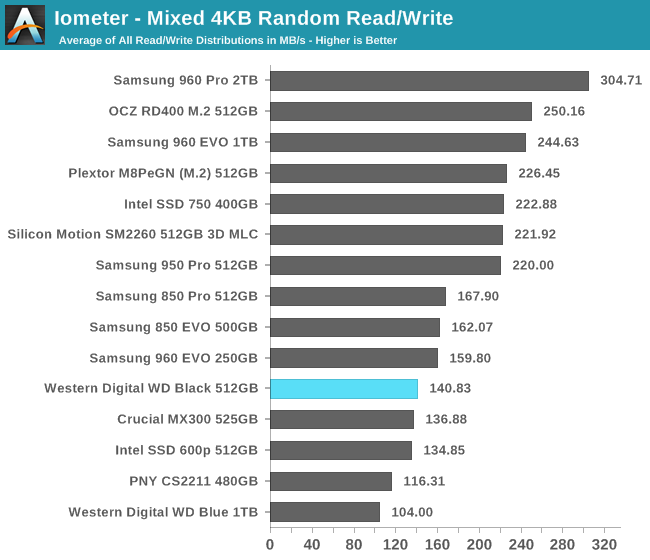
The WD Black's mixed random performance is better than most SATA SSDs and better than the Intel 600p, but both the Samsung 850 EVO and 850 PRO have a clear advantage over the WD Black.
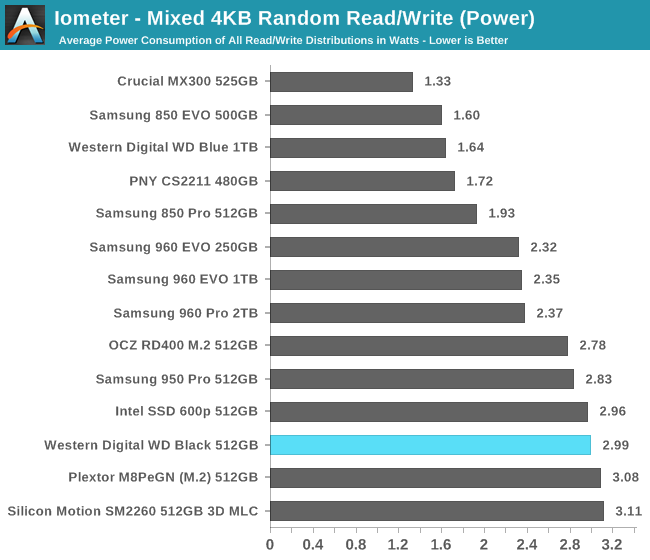
The WD Black's power consumption is a bit high by PCIe standards, but not quite as high as the Plextor M8Pe which uses the same controller. Given the sub-par performance of the WD Black, its efficiency is bad: on par with the Intel 600p, less than half that of the Samsung 850 EVO or Crucial MX300, and far behind that of the Samsung 960 EVO.
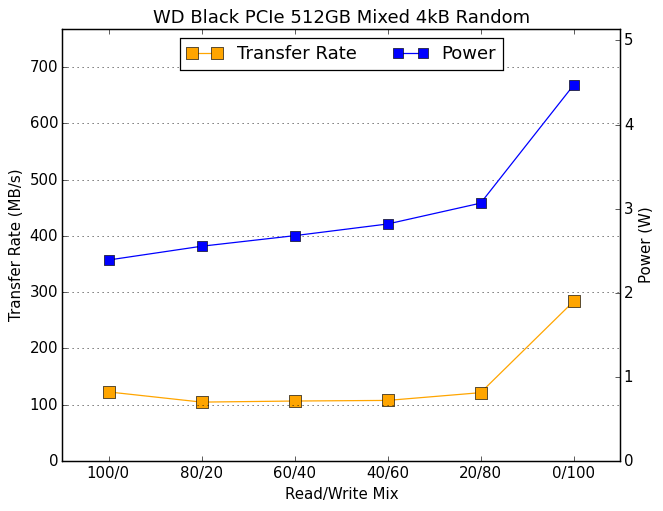 |
|||||||||
The WD Black's performance is pretty flat over the course of the mixed random I/O test, save for the typical jump in the final phase as the workload shifts to pure random writes. The jump isn't high enough to bring the average up above the best SATA SSDs, and the WD Black doesn't show the gradual improvement over the course of the test that the MLC PCIe SSDs experience.
Mixed Sequential Read/Write Performance
The mixed sequential access test covers the entire span of the drive and uses a queue depth of one. It starts with a pure read test and gradually increases the proportion of writes, finishing with pure writes. Each subtest lasts for 3 minutes, for a total test duration of 18 minutes. The drive is filled before the test starts.
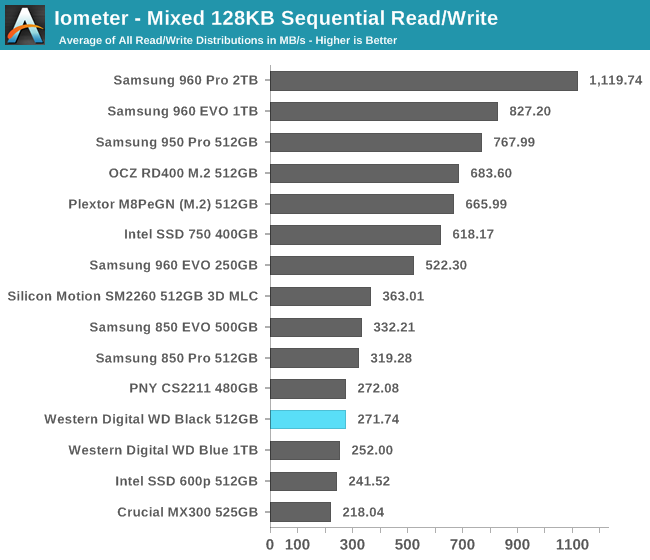
On the mixed sequential I/O test the WD Black performs like a good but not great SATA SSD, with a slight advantage over the WD Blue.
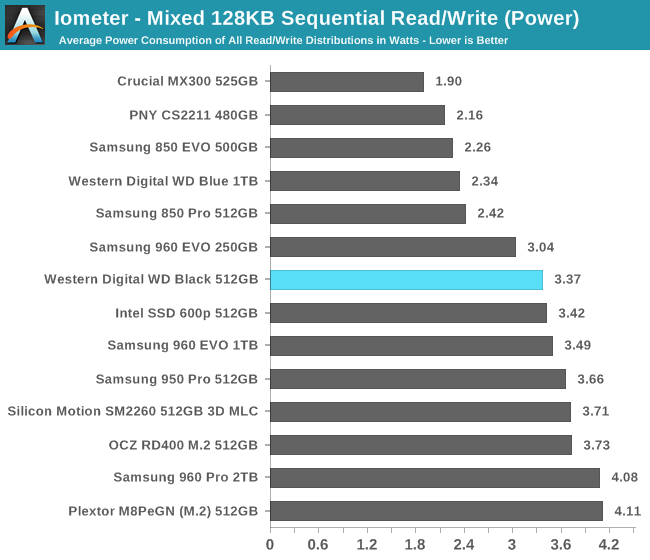
The WD Black's power consumption during this test is on the low side of normal for PCIe SSDs, but its efficiency still isn't remotely competitive with Samsung's 3D TLC.
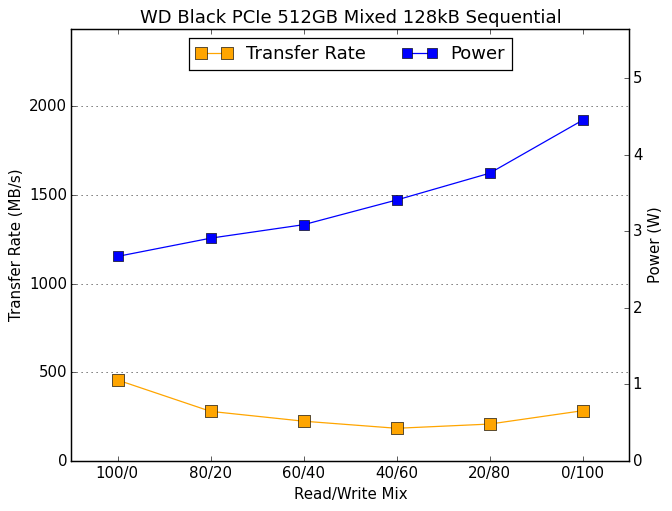 |
|||||||||
The WD Black starts the test with performance near the limit for SATA, but it drops from there as writes are added to the mix. The performance recovers slightly in the final two phases of the test. Power consumption climbs steadily over the course of the test, while most drives manage to reduce power consumption slightly as their performance drops.










36 Comments
View All Comments
BrokenCrayons - Thursday, March 9, 2017 - link
I hope they're not foolish enough to think that producing bottom feeder SSDs will slow the decline of their hard drive business. They're certainly aware of the fact that there are other companies that will land sales that shrink their hard drive business even if they never produce their own solid state storage solutions. It's genuinely perplexing why WD isn't pushing SanDisk to develop a more competitive product line. Maybe they are and this is just a stopgap measure, but I do wonder what's happening.timbotim - Thursday, March 9, 2017 - link
I simply don't get this SSD for desktops. If you're going to be in the slow SSD market don't you just need to be the cheapest? If you're not, what's the point? Do you hope there's sufficient clueless/confused users out there who will buy on availability?I'm pretty sure real user-facing usability is all about QD1 sequential R & W performance (and I'd guess R >> W), and then it's about price. So that's the 960 Pro on performance and the MX300 on price. Everything in between is the best QD1 sequential for the buck (probably why the best sellers are the 850EVOs and SSD PLUSs).
For laptops, replace MX300 with 600p I guess.
Jedi2155 - Thursday, March 9, 2017 - link
It would be nice if you could delineate the NVMe interfaced SSDs versus the SATA models. That way its easier to tell the performance between the two.Qostaarg - Saturday, March 11, 2017 - link
No samsung no party. performance like a potato.Gonemad - Tuesday, March 14, 2017 - link
For me it looks like a great alternative to my ageing rusty spinners for a boot drive on my 8 year old clunker.I won't even have to provision SATA or power cables for it, improving a little bit the cable clutter on my planned upgrade. Faster drives are on the too expensive side, cheaper drives are on the too slow side of the scale, so it becomes a good budget compromise by accident.
This guy has a weird place on the market, and I have a weird upgrade case to do from mechanical clatters, er, platters, so it fits.
Of course I will keep researching into options until the last minute.
jonathan1683 - Wednesday, March 15, 2017 - link
I feel bad when companies make bad decisions like this. I often wonder who made these decisions or if they tried as hard as they could and just fell short. I really like WD as a company, but I see their future may be grim. Hopefully they get it together.